Artopia: January 2010 Archives
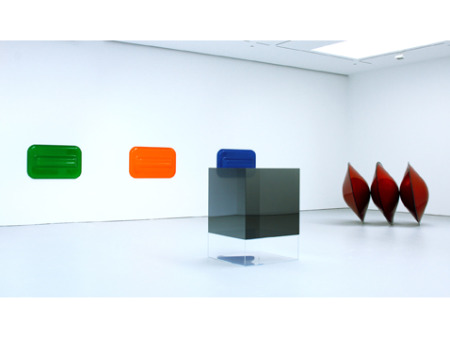
Craig Kauffman: Three Untitled Wall Reliefs, 1968. Vacuum formed Plexiglas
Larry Bell: Untitled, 1969. Mineral coated glass
De Wain Valentine: Triple Disk Red Metal Flake - Black Edge, 1966. Fiberglass
reinforced polyester
Primarily Atmospheric
Mr. McGuire: I want to say one word to you. Just one word.
Benjamin: Yes, sir.Mr. McGuire: Are you listening?
Benjamin: Yes, I am.
Mr. McGuire: Plastics.
The Graduate, 1967
Distance can make things clearer. It's now obvious the '60s were a kind of Cambrian Explosion of art styles.
Five hundred and twenty million years ago there was a biological Big Bang in which millions of new creatures were created. Some became the phyla we now know; countless others are forever gone. The discovery of the Burgess Shale in the Canadian Rockies in 1909 unveiled the imprints of many soft-bodies animals not previously known.
I was turned on to this by Steven Siegel who in 2008 completed a series of 52 wall sculptures called "Wonderful Life" after Stephen Jay Gould's exposition concerning the Burgess Shale.
The Cambrian Explosion as revealed by the lagerstätte of the Burgess Shale gives the lie to the popular notion that evolution proceeds in steady, diagrammatical increments, one step at a time. This may be why the Explosion is not part of common knowledge.

D. W. Miller: Cambrian Explosion, N.D.
Mary Parrish: Hallucigenia
 In any case, I have taken to calling the '60s -- up to the mid-'70s? -- the Cambrian Explosion of Art. So many styles, schools, movements came to the fore that it still boggles the mind and defies synthesis. L.A. Finish Fetish, nominally our Artopia topic today, was only one of dozens of style clusters, not the least of which was Pop Art and Minimal Art. Soon there was also: Anti-form, Video Art, Fluxus, Performance Art, New Realism, Photorealism, Kinetic Art, Conceptual Art, Earth Art. Finish Fetish, Funk, Hairy Who, Psychedelic Art, Neo-Dada, Environments, Installations, Mail Art and on and on. And although the U.S. bore the brunt of the explosion, a burst of new art appeared in Europe, Asia, Latin America too.
In any case, I have taken to calling the '60s -- up to the mid-'70s? -- the Cambrian Explosion of Art. So many styles, schools, movements came to the fore that it still boggles the mind and defies synthesis. L.A. Finish Fetish, nominally our Artopia topic today, was only one of dozens of style clusters, not the least of which was Pop Art and Minimal Art. Soon there was also: Anti-form, Video Art, Fluxus, Performance Art, New Realism, Photorealism, Kinetic Art, Conceptual Art, Earth Art. Finish Fetish, Funk, Hairy Who, Psychedelic Art, Neo-Dada, Environments, Installations, Mail Art and on and on. And although the U.S. bore the brunt of the explosion, a burst of new art appeared in Europe, Asia, Latin America too.
Yet we have about as much explanation for the Art Explosion as for the Cambrian one. The Cambrian Explosion may have been caused by a radical change of environment, such as the break-up of Gondwana, then
earth's solitary land mass. Or maybe something else.
Hasn't everyone noticed that an unprecedented number of art styles fluoresced in the '60s? It is all pushed under the rug of art history and dismissed by the formalists, structuralists, and poststructuralists as "pluralism" -- before the official pluralism of the '70s, also disdained. Art styles are supposed to succeed one another in an orderly fashion, just like those quaint illustrations showing a neat staircase from amoebas to fish, fish to reptiles, reptiles to apes, apes to Man -- just as socialism was supposed to be the logical outcome of capitalism. Simultaneity, discontinuity, multiplicity, backsliding, mutations, detours and braiding are not allowed. I need only refer you to the recent exhibition "1969" that, though it did include some samples from the Finish Fetish group, left everything else out except Minimalism and its offshoots. probably because MoMA's collection, the source of the exhibition, largely does the same.
Well, never mind. Though sometimes I think my brain is the Art Explosion lagerstätte, we can't keep the facts hidden for long. Everything old is new again. Products pushed aside are once more viable, hence the various commercial gallery ventures into recent histories.
But the question of why there was the Art Explosion still needs to be answered, so here are some theories about the phenomenon in the United States:
Because of the G. I. Bill, more people than ever were privy to art education. And for those who passed through the academic mill, there were teaching jobs too.
In the '50s, "beatnik" subculture and Action Painting in the pages of Life magazine planted the seeds. Disillusion with such official government activities as the Korean War and the Red Scare made art seem righteous and noble. The election of Kennedy sealed the deal, and good times were afoot. Or so it was thought.
Being an artist became an honored career choice. By 1960, it was obvious that some were becoming rich from art, even artists -- rich and, more important, famous. Art and artists suddenly made good copy.
The National Endowment for the Arts individual-artist grants started in 1965.
Just as in fashion, art needed something new each season. The art world, newly born, graved new artists, new styles, new copy, new products, new news. There was suddenly an art public, and that mob was voracious. Elizabethans constantly craved new plays, Venetians went mad for new operas and new singers, and Victorians coveted new and newer serial yarns. In the '60s, New Yorkers -- and art-lovers in all major cities -- coveted the new in art.
There was a void to be filled. After the Man in the Gray Flannel Suit, the world needed new art and new artists in hip clothes. Down with unproductive, boring, unsexy conformity. New art equals new thoughts. Rock 'n' roll had already loosened things up. Bombarded by TV images, the public wanted more.
Nothing was sacred. Because of an idiotic war, sexual liberation, recreational drugs, and assassinations, Western society was going through a cultural Gondwana. Chaos opened the door to innovation.
The Art Explosion was, like the Cambrian Explosion, overdetermined. Then why did it stop? There were some '70s aftershocks: feminist art and P&D. From then on, though there were individual artists of great talent, the packaging become increasingly forlorn. Neo-Geo? Graffiti Art, Neo-Expressionism? The Pictures Generation? In comparison, boring Minimalisms now seem sublime.
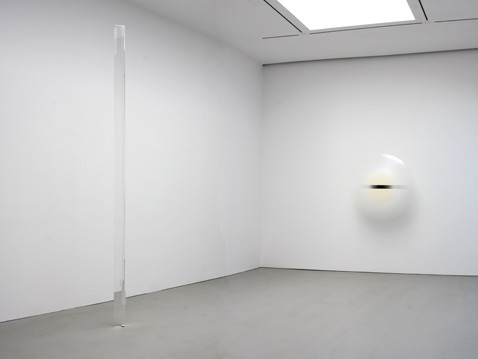
Robert Irwin: Untitled (Acrylic Column), 1970-71
Untitled, 1969. Acrylic lacquer on acrylic plastic.
Collection: San Diego Museum of Contemporary Art
What Minimalism Wasn't
1. Californian.
2. Beautiful.
3. About perception.
4. Made of plastic.
5. About light and smog.
6. About surface perfection.
Curator Kynaston McShine's "Primary Structures" at the Jewish Museum in 1966 lumped them all together: Anthony Caro, Phillip King, Tim Scott and other Brits, major Minimalists; Park Place sculptors (for instance, Forrest Myers, Peter Forakis, David von Schlegell) and two Finish Fetish folks from California, Larry Bell and John McCracken. Also included were Judy Chicago and Robert Smithson. The important aspect of this mélange was that none of the artists were Abstract Expressionist sculptors. There weren't too many of these who looked like they were going to count. Seeing Caro as David Smith's successor was a stretch. But McShine was casting a wide net.
The closer you look at things, the more they fall apart.
Now, with the wisdom that time confers, we can see that the "Primary Structures" exhibition, which seemed not to please any of the artists, was rather like putting elephants, cats, monkeys and mice in the same room, merely because they all have tails. The elephant might know there was something wrong, but would not have the wherewithal to explain that cats meowed, monkeys chattered, and mice squeaked. Certainly none of them smelled like elephants.
We have nothing to say about Caro, nor much occasion to say it. The same can be said for the Park Place gang. But because of "Primary Atmospheres: Works from California 1960-1970" -- another museum-quality show at David Zwirner (519, 525, and 533 West 19th, to Feb. 6) -- and because of my offhand dismissal of the Finish Fetish group included in "1969," recently at P.S.1, we have a bit more to say about California "Minimalism," which came on the heels of the New York brand, and was -- surely we can see that now -- a different kind of animal.
The "Light and Space" artists (I don't remember them being called that way back when) are not pseudo-Minimalists -- as I opined recently, alas. What they share with the pioneering MInimalists is a commitment to simple geometric structures, the avoidance of a handmade look, and the denial of anything gestural or expressionist. I purposefully say "the avoidance of a handmade look" because sometimes this look is gained by laborious hand-work, as in the hand-crafted color planks of McCracken. Without the layering and sanding and polishing, they would not be nearly as slick as the surfboard surfaces they imitate -- or as color-saturated, in their monochromatic density.
There was a reason that the art now dubiously labeled "Light and Space" and sampled under the better title "Primary Atmospheres" at Zwirner was sometimes referred to as California Finish Fetish. The space-industry emphasis on perfection is in itself reason enough to divorce the art from Minimalism per se.
Although Donald Judd sometimes went after some fairly fancy finishes, Minimalism in general was not about finish and surface (yes, call it what it is), but about objectness, even when that objectness is expressed by store-bought fluorescent lights and was in part defined by the light emitted as well as the fixtures and tubes.
Using the rubric "Light and Space" makes it easier to justify the inclusion of artists working with light, such as James Turrell and Robert Irwin.
But isn't plastic the common denominator of this group? In the '60s, plastic wasn't the Neo-New, it was the New Bad. It was bad everywhere except Southern California, where plastic, we on the East Coast thought, was a way of life.
Well, there are two handsome oil-on-canvas paintings by Irwin in the Zwirner survey. The cubes by Larry Bell are actually glass. And Turrell's light projections are certainly not made of plastic.
Simple geometry? Craig Kauffman's three vacuum-molded wall pieces and De Wain Valentine's Triple Disk Red Metal Flake -- Black Edge are hardly illustrations of that.
I tried to make a chart to show what Peter Alexander, Bell, Laddie John Dill, Irwin, Kauffman, McCracken, Helen Pashgian (new to me), Turrell, Valentine, and Doug Wheeler actually have in common.
There is no common denominator, no necessary characteristic. Neither light, space, plastic, nor simple geometry will do the trick. Finish Fetish doesn't apply to all of them, either. How can Turrell's projected light, as in the two pieces shown here, have "finish"?
So Finish Fetish is an art movement without a common denominator and with a somewhat derogatory name.
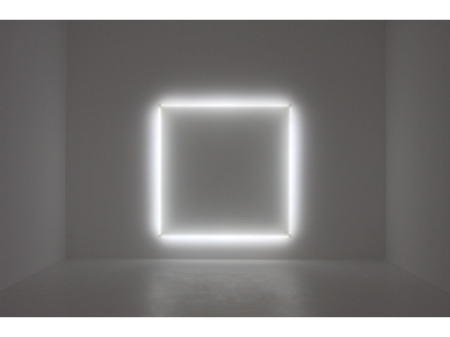
Doug Wheeler, Untitled, 1969. Acrylic, neon tubing and wood.
And the Solution Is.....
I was puzzling over the lack of a necessary and sufficient characteristic, until I suddenly remembered a pedagogical strategy I used in the '60s derived from Ludwig Wittgenstein's later philosophy: the anti-Aristotelian Family Resemblance. A category can consist of items that have a family resemblance rather than a necessary and sufficient common denominator. On a macro level, family resemblance can be used to delineate art in general; on a micro level it can be used to describe a style or art movement.
I have my father's steel-gray eyes and reddish beard, but my mother's soma-type (I hope). Whereas my sister has my mother's blue eyes, my father's soma-type, and my aunt's tendency to indulge in monologue. My brother has my father's eyes; my mother's blond hair and my grandfather's weak heart. I have my grandmother's and my mother's green thumb, but my brother doesn't. He has instead my father's mechanical ability, which neither my sister nor I possess. One big, happy family, with enough cross-references to enable identification as such.
Well, O.K. But couldn't you say the same thing about the varied art in the 1966 "Primary Structures" exhibition, that there was indeed a family resemblance?
No strategy is perfect, and Wittgenstein wasn't entirely right. It is how you use a strategy and what you use it for that counts. And let us not forget that classification can be ossification. Categories should be for illumination and comparison, not for control.
Family resemblance works for showing generosity to things you like; "necessary and sufficient" works if you want to weed your garden and get rid of all the plants you didn't plant, like dandelions, although dandelions are perfectly edible. They are sometimes just in the wrong place.
But surely there are other strategies, such as sorting by hindsight.
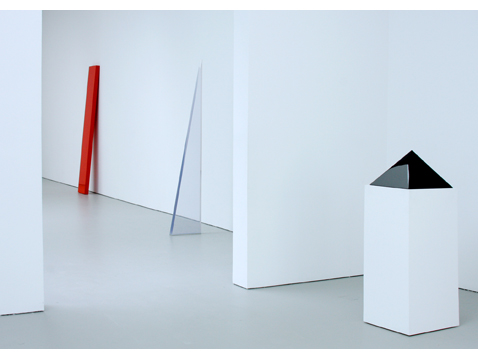
John McCracken: Red Plank, 1967. Polyester resin, fiberglass and plywood.
Peter Alexander, Blue Wedge, 1970/ Cast polyester resin.
McCracken: Black Pyramid, 1975. Polyester resin, fiberglass and plywood.
Insight by Hindsight
If we still must judge art by its influence on future art -- a very big "if" -- then how does Finish Fetish come out? We can say that Minimalism itself influenced Anti-Form and Earth Art, and certainly Conceptual Art. But so far we see no developments out of Finish Fetish. Reactions against, no doubt. Mess instead of finish and finesse, which we decline to find game-changing or even interesting. Finish Fetish is a sport.
On the other hand, what U.S. city has its own art movement? New York has had dozens. But in all the rest of the United States of America, there are only three. L.A. produced Finish Fetish; Chicago gave birth to The Hairy Who; San Francisco briefly floated Funk. All are worth reexamining.
Was Finish Fetish the beginning of New Age art? Unlike in Minimalism, a lot of the work in "Atmospheric Structures" looks semi-mystical. This is certainly true of Irwin's demisphere with light and shadows. And, as we shall see, of McCracken's planks. Simple geometry, unless you are very careful, will always suggest the Platonic.
 Coda: Readymade, Shop-made, or Handmade
Coda: Readymade, Shop-made, or Handmade
The New York Minimalists rediscovered the idea that you didn't have to make things yourself in order for them to turn out to be art. We know that Duchamp did this first with his Readymades, but for some reason Dada was anathema to Judd, Flavin, LeWitt. Was it Duchamp's Dandyism? His odd connection to the lingering decadence of Surrealism? Certainly not his friendship with the rich and well-positioned, since no artist ever turns down a free meal, no matter how expensive the china.
Perhaps you cannot honor Dada when you are trying to sell made-to-order art for handmade prices and questioning art would queer the sale. So let us say instead that the major Minimalist "didn't make art" in the same way that Duchamp "didn't make art." A Minimalist eschewing the handmade meant something different than what Duchamp meant by selecting his urinal or his bicycle wheel.
I am tempted to say that Minimalism, although producing unique objects, embraced the mass-produced -- or it looked like that. Minimalism wanted the matter-of-fact rather than the pristine.
On the West Coast, the surface was the subject, and perception rather than philosophy was the point. Or to make light of it: not what light might mean, but how light could be seen -- on a clear day, theoretically without smog, when gazing at your surfboard or the fender of your car. West Coast Minimalism might really be abstract Pop -- Pop without dust or imagery. If you really want to get at the difference between Minimalism and the best of the Finish Fetish folk, compare anything written by Judd to this statement by McCracken:
I was always primarily interested in form alone, but then to make a form, you have to make it out of something. So color seemed a natural material to use, because color is abstract. If you make a form that appears to be composed of color, then you have something, an object, that's pretty abstract. Just form alone would be more abstract, of course, because it's just a mental idea, but you don't have anything there for your perceptions to grapple with unless you make it out of a material. However, if you make it out of metal, or stone, or wood, or whatever, then you have something that to my mind may overemphasize the physical aspect and therefore be difficult to perceive as purely mental. An important thought behind this is that all things are essentially mental - that matter, while quite real on the one hand, is on the other hand composed of energy, and in turn, of pure thought.
John McCracken quoted from an interview with Thomas Kellein, August 1995, in the catalogue McCracken, Kunsthalle Basel 1995, p. 22. Courtesy Gallerie Tanit, Munich.
And that's not all. There is a difference between early '60s and mid-'60s, by which time New York Minimalism was already something to subsume or survive. On the West Coast, beauty did the trick, where beauty meant perfect and shiny. A decade later, the P&D artists had another definition of beauty and another answer to Minimalism. And now we can no longer think about beauty at all.
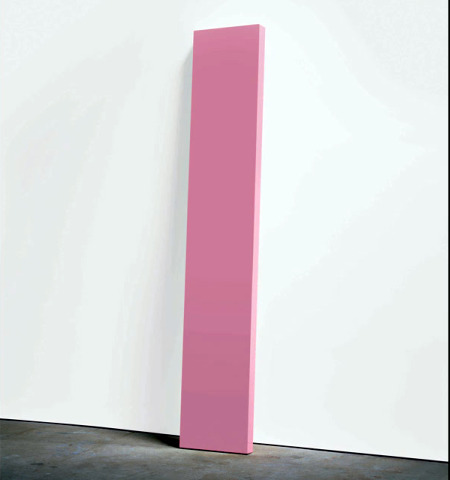
McCracken: Think Pink, 1967. Polyester resin, fiberglass, and plywood.
Where Is the Aura?
After my aura riff last time around, I now use the term whenever I need a space-holder for something unexplained. Don't know why one painting is worth millions and another less than the cost of the canvas and paint? Aura!
Can't figure out why you are moved by de Kooning and not Robert Motherwell? Aura!
Find it difficult to understand how an appraiser can tell a fake Mondrian from a real one? Aura!
Puzzled by the positive experience afforded by an early Frank Stella contrasted to the boredom inspired by later, more varied work? Aura!
So...
Does any of the art in "Primary Atmospheres" have an aura? You would think that works by Irwin and Turrell, or even the boxes of Bell, having so much to do with light and perception, would have auras. But that is the case only if you assume that aura has something to do with the spiritual, a dubious premise. Auras in art are not like halos. Nor do art auras have to do with perception.
Although I have doubts about his columns and other forms, McCracken's planks have aura. He makes them by hand in the same way surfboards are made. Neither fish nor fowl; neither paintings nor sculptures but both, they have the oddness of the interstitial. And we all know from anthropology that everything interstitial is aurific.

NEVER MISS AN ARTOPIA ENTRY! ASK FOR THE AUTOMATIC ARTOPIA
ALERT: perreault@aol.com

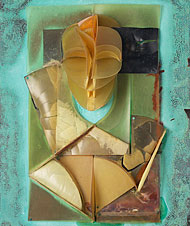
Antoine Pevsner,Portrait of Marcel Duchamp, 1926. Cellulose nitrate on copper with iron, 65.4 x 94.0 cm (25 3/4 x 37 in.) Yale University Art Gallery. Gift of Collection Société Anonyme. The works originally clear plastic components now show extreme signs of degradation, including warping, cracking, and discoloration, which exacerbated corrosion processes in the metal pieces. Photo: Yale University Art Gallery. ©2009 Artists Rights Society (ARS), New York/ADAGP, Paris. Caption: GCI Newsletter.
The Doritos Syndrome
If it has never occurred to you how fragile works of art are, start worrying now. Temperature, humidity, and people looking at them can make them age, wrinkle, fall apart. And we can blame artists, too. They persist in playing with time-bound products like fluorescent lights and various video formats; they even distribute and store their art electronically on YouTube. Are YouTube and Picasa eternal? Is The Cloud, located in server forests somewhere in Switzerland or China, invulnerable to time and fortune?
Writers, you are not secure either. The New York State Archives recommends that electronic texts have paper backups and that electronic files be copied every three to five years, even to the point of "migrating" them to a new system.
But art has been asking for trouble for a long time. Artists of the last century indulged in unstable materials. Naum Gabo and his brother Antoine Pevsner enjoyed making sculpture out of cellulose nitrate back in the USSR. So much like glass, but lighter, unbreakable and easier to handle; so new.
At a 2007 conservation workshop at London's Tate, there were "collective gasps" when an original Pevsner, now looking like a "plate of Doritos," was shown next to an image of a recently constructed replica of what it had looked like in its glory day.
Cellulose nitrate is bad enough; think of fat and felt; of earth, blood, semen, garbage. Hot dogs.
Carol Mancuso-Ungaro (associate director for conservation and research at the Whitney Museum) in Conservation Perspectives, the Newsletter of the Getty Conservation Institute, reports the following anecdote offered by her British colleague Herbert Lank:
An auction house had received for sale a construction by Beuys of a German U-shaped knackwurst suspended from a rod by shoelaces. Unfortunately the Dutch owners had taken it off the wall overnight before packing. On returning in the morning to do so, they found that a large chunk had been bitten out of the base: their parrot was lying dead on the floor.
Joseph Beuys, when asked about what to do, replied that a new sausage would not be a solution because the original was by then 10 years old, and that the "patina" was an essential element of the work.
"Lank," reports Mancuso-Ungaro," meticulously restored the missing part."

Inherent Vice: When Sleepers Awake
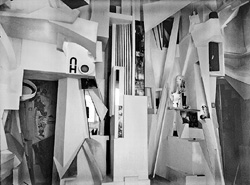
One day you will awaken and realize that all the artworks you love are replicas.
Art was too precious, unstable, and far too difficult to preserve, conserve and insure. The expense was enormous. Since lost monuments of modernism such as Kurt Schwitters' unfinished and abandoned Merzbau, 1919-37 (1981-83) [above] and El Lissitzky's Prounenraum, 1923 (1971) had already been replicated from photographs and the facsimiles often accepted as art, it seemed sensible to replicate all art in the face of unpredictable disasters and inevitable decay.
Let there be light. But light of any kind hastens art's demise. Art objects are vulnerable even to slight fluctuations of temperature and humidity, never mind the wild variations that occur when feedback systems are in error or do not work fast enough to take into account persons daring to gaze upon these ultra-sensitive fetish objects.
We believe in reincarnation. We already know Performance Art can be experienced in restagings and reinterpretations. Pieces by Allan Kaprow such as his 1961 Yard (previously discussed on Artopia) now have a history of official "reinventions." Long-forgotten Fluxus Events have come back to life, reexisting in restagings by Fluxconcerts and others.
You may not be able to step into the same river twice, but water is always water. Or is it really the other way around? As long as it keeps its name, the river is the same.
In Artopia we have noted the witty works by Stephanie Syjuco in "1969" at P.S.1/MoMA that are clearly replicas and labeled as such. The "real" works were off-limits and could not be borrowed from MoMA itself because P.S.1 does not have climate control.
Excluding personnel triage and decimated endowments, within the museum field conservation, restoration and replication are the hot topics. Three tasty threads, listed and linked below, make up the main sources of our intertextual braid. Here are tales of despair and repair, wherein even artists are vague and change their minds. If you think that correct labeling is all that is involved, then think again. Here are occasions for your enlightenment, titillation and despair:
Tate Papers: Inherent Vice: The Replica and Its Implications in Modern Sculpture. A multitude of terse papers presented at an international workshop at the Tate Museum are so full of information and complicated points of view they will make your head spin, your eyes roll, and your temperature rise. Info on the works of Gabo, Eva Hesse, Damien Hirst, Helio Oiticica, Dieter Roth, Vladimir Tatlin and others.
Museum: Saving Collections. Not just a pitch for the green museum but a vision gleaned from the field, concerning the future of museums. Rising tides mean historic buildings will have to be moved -- possibly indoors. And facsimiles will lead the way to an uncertain future.
Conservation Perspectives: The Getty Conservation Institute Newsletter, Fall 2009. Essential for anyone in the visual arts. David Hockney gets his acrylic painting cleaned; everyone kvetches. Original artworks are seriously wounded or totally doomed.
 Cover of Conservation Perspectives
Cover of Conservation Perspectives
Dan Flavin, Untitled, 1976. Pink, green, and blue fluorescent light, 8 ft. (244 cm) high leaning. Dan Flavin Art Institute, Bridgehampton, New York. Fluorescent tubes are no longer widely available in the diameters or colors used by Flavin. Although tubes can be custom-made and stockpiled, this technology will likely become obsolete, posing a long-term challenge for conservators of Flavin's works. Photo: Florian Holzherr. Collection of Dia Art Foundation. © 2009 Stephen Flavin/Artists Rights Society (ARS), New York Caption: GCI Newsletter.
|
|
|
|
Change or Die
In Museum, the journal of the American Association of Museums, Elizabeth Wylie and Sarah S. Brophy ("Saving Collections and the Planet") summarize the predictions they have gathered: "Professional practice must change, and the power of the original will shift in weight and meaning."
Some immediate steps to take are more efficient climate control in public spaces; segregated storage; use-keyed lighting. Even in very popular museums, galleries are empty more than half the time. Do the lights have to be on when no one is there?
As Valentine Talland of Boston's Isabella Stewart Gardner Museum opines, in the past we knew about light and fading but didn't "anticipate the burden of access and its role as a variable in deterioration." Or as summarized by the authors:
Maintaining climate conditions in storage (a controlled environment) is one thing: maintaining conditions in the galleries is another, with variables like heat-producing artificial lights and lots of breathing, moving people skewing conditions so systems must work harder.
The Gardner Museum in Boston originally received 1,000 visitors a year and now entertains 200,000.
" Who are we responsible to, Mrs. Gardner's display or the Sargent watercolor?" asks Gianfranco Pocobene, the Gardner's head of conservation. "The museum is replacing some vulnerable textiles and works on paper with facsimiles to ensure their long-term preservation while addressing the historiographic aesthetic of the display."
The paradox - whether suffered by the preparator, the conservator, or the curator -- is this: displaying art is inimical to preserving it.
In this regard, when it comes to artworks on the level of the Mona Lisa or Picasso's Les Demoiselles d'Avignon, it has long been rumored in Artopian circles that the real artworks have been locked away to prevent theft or damage from persons or the environment, and skillful replicas are employed as unannounced stand-ins.
Artworks are easily faked, sometimes with wicked purpose: aesthetics, irony, destabilization of rigid points of view. See: Sherrie Levine, Elaine Sturtevant, Mike Bidlo and other appropriationists. The skill sets are readily available. Facsimiles could replace every artwork in MoMA or the Met and no one would know the difference unless they were labeled as replicas.
* * *
John Perreault: Mended Rock (for Beth), 2006.
Private collection, Scottsdale, Az.
Mr. Fix-It
And then I was looking through Fall 2009 Conservation Perspective, the newsletter of the Getty Conservation Institute. Yes, yes, I am interested in such things: art and decay; mending things.
I, who once used acrylic paints before switching to Vegemite and then toothpaste (I'm not kidding), actually read "Cleaning Acrylic Emulsion Paintings" by Bronwyn Ormsby and Alan Phenix. Acrylic surfaces are rarely varnished, so there is no protection from dirt and grease. And fingerprints from improper handling? Forget about it. Acrylic is a dirt magnet.
Cleaning agents themselves can be dangerous too and need to be tested by: an HTP cleaning test device; automated image analysis coupled with data mining, and atomic force microscopy; and/or parallel dynamic mechanical thermal analysis and de-absorption electrospray ionization mass spectronomy.
The lead article by Thomas Learner, G.C.I.'s senior scientist, had already set the worrying tone by not only pointing out the ill-conceived use of cellulosic plastics by Gabo and Pevsner, but also the folly of Hesse's signature employment of untested polyester resins and synthetic latexes. Surely one may wonder if the remnants of a hanging anti-form piece now deployed on the storage floor like the skin of a flayed corpse is really what the artist had in mind to leave for posterity. Furthermore, a partial mockup of a 1968 plastic wall piece fabricated by her former studio assistant using the original molds now in his position, reveals by its ugly transparency the poignant changes wrought on the original sections now surely slated to entirely decay or at least evolve into the totally opaque.
When the artist's hand was never involved in the first place, restoration may not be a problem. We see a photo showing a rusting section of Sol LeWitt's 49 Three-part Variations on Three Different Kinds of Cubes next to the completely sanded and re-enameled restoration.
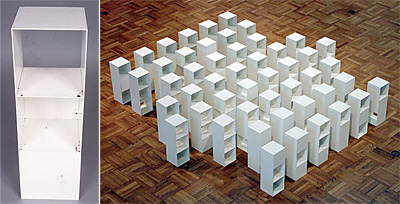
Sol LeWitt, 49 Three-Part Variations on Three Different Kinds of Cubes, 1967-71. Enamel on steel, 49 units, each 23 5/8 x 7 7/8 x 7 7/8 in. (60 x 20 x 20 cm). Allen Memorial Art Museum, Oberlin College, Oberlin, Ohio; Fund for Contemporary Art, 1972. LEFT: Detail of one of the units. RIGHT: Post-treatment installation view. The discoloration and cracking affecting 33 of the units was deemed sufficiently antithetical to the artists intent of a perfectly white, unblemished surface that removal and reapplication of the enamel was considered a justifiable treatment. © 2009 The LeWitt Estate/Artists Rights Society (ARS), New York.Caption: GCI Newsletter.
In Artopia, we suspect that some masterpieces have been so conserved, preserved and restored that they are no longer the original artworks.
Restoration is a slippery slope. First you replace the discolored plastic parts, then the rusty metal, then the rotten wood -- and there is nothing left of the original. It is like the plastic surgery addict who moves from lips and eyelids to full face and then the whole body and wakes up in the morning and looks in the mirror wondering who she (or he) is. Where did the real me go?

It is like Jason's ship the Argo, now a metaphor for everything postmodern and poststructuralist:
A frequent image: that of the ship Argo (luminous and white), each piece of which the Argonauts gradually replaced, so that they ended with an entirely new ship, without having to alter either its name or its form. This ship Argo is highly useful: it affords the allegory of an eminently structural object created not by genius, inspiration, determination, evolution, but by two modest actions which cannot be caught up in any mystique of creation: substitution (one part replaces another is its paradigm) and nomination (the name is in no way linked to the stability of the parts): by dint of combinations made within one and the same name, nothing is left of the origin. Argo is an object with no other cause than its name, with no other identity than its forms...
Roland Barthes, Barthes by Barthes, Macmillan, 1976
Curiously, one kind of author (the novelist, the artist, even the poet) is subverted in favor of another, lesser kind of author: the critic. The secondary subverts the primary. A deeper understanding of the Argo trope is that there are no art objects; there is only grammar.

The End Is at Hand
And what makes you think facsimiles are not already widespread?
Rethinking the standard denial, Jill Sterrett of S.F. MoMA admits that "we are in the business of making replicas all the time with forms of contemporary art and certainly photography..."
....there have been remarkably creative solutions for tours of a photographer's work, which have relied on authorized exhibition copies that travel and that allow these works to be seen by millions of people. We copy -- or migrate -- video all the time. That's a process that we've also accepted as underpinning the way that we keep video installations alive.
And now this:
Although for a short moment he thought that replacing a damaged segment of a Gabo sculpture showing little evidence of the artist's hand might be fine, Matthew Gale, head of displays at the Tate Museum, confesses he went on to think that...
...the presence of that thing in the world would raise questions. Does it [the artwork with a replaced part] adequately substitute for the original? If the original becomes completely unrecognizable, does the aura inevitably migrate to a second physical object? I seems to me that it does.

The Curious Case of the Migrating Aura
Let us consider Performance Art revivals, interpretations, restagings, replicas, recreations, reinventions. Is the James Lee Byars' Question Piece the same performance piece if the long-dead artist is played by an actor? That actor's stage presence is not Byars' stage presence. Similarly, it may be impossible to replicate Beuys' How to Explain Pictures to a Dead Hare, or, perish the thought, a John Perreault Circumambulation ages hence, when the digital files have disintegrated and the YouTube Cloud has dispersed.
Perhaps my presence will migrate somewhere too, the way Gale suggests an aura can migrate from an artwork to a replica.
Not only do we want to understand the use of the word aura in art before Walter Benjamin's famous essay "The Work of Art in the Age of Mechanical Reproduction," we want to know much, much more.
In Artopia, we know that aura in art is suspiciously like charisma, which in turn is like stage presence -- charisma and stage presence ascribed to persons rather than objects.
Max Weber defined charisma as:
...a certain quality of an individual personality, by virtue of which one is "set apart" from ordinary people and treated as endowed with supernatural, superhuman, or at least specifically exceptional powers or qualities. These as such are not accessible to the ordinary person, but are regarded as divine in origin or as exemplary, and on the basis of them the individual concerned is treated as a leader.
Change a few words and the subject could be the aura in art.
But is aura a figure of speech, as in Benjamin, or a substance, as in common usage, allowing it to swell, shrink, attach and detach itself, even migrate? And what is the relationship of aura to mana? Or mana to...
Adur -- Basque
Asha -- Iranian
Ashe -- Yoruba
Ichor -- Greek
Inua -- Inuit
Ka -- Egyptian
Maban -- Australian Aboriginal
Manetuwak -- Leni Lenape
Manitou -- Anishinaabe
Numen -- Roman
Orenda -- Iroquois
Prana -- Yoga
Seid -- Norse
Sumesh -- Salish-Kootenai
Teotl -- Aztec
Vaki -- Finnish
But perhaps artworks do not have to have auras to be art. In 1936, Benjamin claimed that photographs and movies were without auras and therefore -- mysteriously, I think -- suited for left-wing politics. But Sergei Eisenstein, on the left, was not the only one making propaganda films.
Had not Benjamin seen Nazi newsreels or Leni Riefenstahl's 1934 Triumph of the Will?
Few would doubt now that photos and movies can be art. Both can serve power, as did the Benjamin-identified auratic art that came before, but now it is corporate power. And many, I will guess, think they perceive cinema-aura and photo-aura -- not only emanating from relics of discarded image-snatching systems, but for current products, much aided by the photogenic presence of actors and the crude uses of myth.
One wonders if the application of aura can be taught in the same way some claim to teach "presence" to rock-star wannabes and fledgling belly-dancers.
An eye-opening treatise by a Middle Eastern dancer by the name of Amira Jamal is not a tease but a tip sheet full of counterintuitive advice: focus your gaze over their heads, over and beyond their eyes.
NOT having constant eye contact, especially if on a raised stage, is an important element to stage presence. Yes, you read right: NOT having eye contact. A performer has to look out over her audience.
Yes, every once in a while, you should make here-and-there eye contact, but make it a habit to look out beyond and up. If you just skim the heads of the audience, for the most part, you will give the impression you are making full eye contact. An audience member will know that you are not making eye contact with him/her, but he/she will be certain you are making it with someone else!
That may explain Marilyn Monroe's screen presence. She was myopic and shy, never looking the camera in the eye. I am definitely going to try this out when I speak at the National Council on Education for the Ceramics Arts conference in Philadelphia this spring. A bit of extra presence can't hurt that shindig.
Charisma -- the aura of persons -- may also be a matter of staging. Look strange. Appear bigger than life or wear a funny mustache. Enter from stage right. Position yourself at center.
I really don't want to Satchmo you. When asked to define jazz, Louis Armstrong would answer, "If you have to ask, you'll never know." Art historians, critics, curators, and connoiseurs have been known to say the same about the aura in art.
Aura, it would appear, is the mysterious, unseen essence. Nevertheless, creating aura in art is easy. It's all done with positioning, with spots and pedestals. But the price tag says it all.
Perhaps we should do some testing.
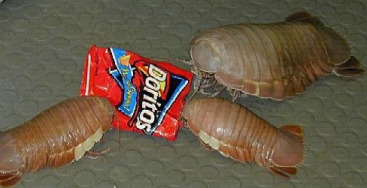
Aurafication Is My Vocation
1. The Bauhaus Test
Go to MoMA's website for their splendid design show: "Bauhaus 1919-1933: Workshops for Modernity" (to Jan. 25).
Watch the László Moholy-Nagy movie.
Read everything and look at everything: all the texts, photos and reproductions. You can do it sitting down. Take Kandinsky's color/shape test. Should a triangle be red, yellow or blue? You can compare your choices with those of his Bauhaus students...and the meaning of this? Well, never mind.
Then visit the exhibition at MoMA and compare your experience. This is the perfect exhibition to use in search of the aura, since the Bauhaus inaugurated the valorization and/or the aestheticization of mechanization in an influential way.
 Clues: I personally thought Moholy-Nagy's Lightplay projected near his Prop for an Electric Stage, itself the subject or "creator" of the abstract moving shapes captured on film, was more interesting at MoMA than on my computer by itself. I felt the Anni Albers weavings, sort of humdrum at home, were glorious in person. But couldn't decide between aura or increased sensory data as the cause. I mean, after all, weavings in real life are not simply flat the way they appear on your screen. They have texture.
Clues: I personally thought Moholy-Nagy's Lightplay projected near his Prop for an Electric Stage, itself the subject or "creator" of the abstract moving shapes captured on film, was more interesting at MoMA than on my computer by itself. I felt the Anni Albers weavings, sort of humdrum at home, were glorious in person. But couldn't decide between aura or increased sensory data as the cause. I mean, after all, weavings in real life are not simply flat the way they appear on your screen. They have texture.
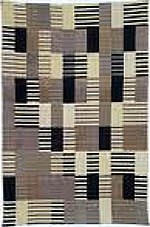
2. The Replica Test
See if (a) art students, (b) artists, (c) art critics, (d) curators, (e) collectors can tell the difference between artworks and their replicas in matched pairs. The works must be unknown to the subjects. Therefore, it will be necessary to commission paintings -- we will limit ourselves to paintings -- from unknown artists. Then these in turn will be replicated by others. Or, because artists have been known to make replicas of their own work for financial gain, perhaps each replica should be made by the artist who made the original.
3. The Aura Test
Using the same art victims as subjects, ask them to choose which artworks in The Replica Test, if any, possess aura.

I am sure you are beginning to have that sinking feeling. If an art object is vulnerable to time, then so are we. Art stands for a kind of immortality. No one wants to be reduced to a plate of Doritos or end up looking like a cosmetic surgery victim. Furthermore, if we cannot tell the difference between an original and a replica, then perhaps we can't tell the difference between right and wrong, friend and foe.
And is Kenneth Baker friend or foe? Can art criticism be simulated?
The San Francisco Chronicle's conservative art critic bottomed out his New Year's list with this:
Cultural critics have decried simulation creep since the 1930s, but in century 21 the Internet has exponentially exaggerated the false equivalence of reproductions and realities. Postmodernist declarations of the end of originality played their nefarious part - though when did we last hear one? Even a critic who stands for nothing else nowadays must still stand for direct encounters with artworks.
We should know better. We need to mend our ways. Given the Readymades of Marcel Duchamp and Man Ray (they are so 20th century), and given Conceptual art, which is everywhere, we are already halfway there. If an artwork is replaced by a replica, should we be disappointed?
No. Art is in the idea, not in the manifestation, which is merely the vehicle. Plato would be thrilled. We need not mention Benjamin and Barthes ever again.
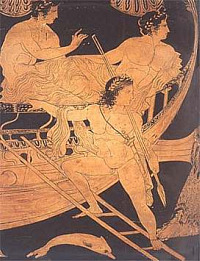
NEVER MISS AN ARTOPIA POST....
FOR AN AUTOMATIC ARTOPIA ALERT PLEASE CONTACT: perreault@aol.com

